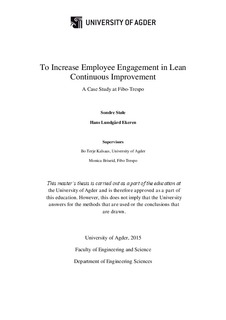| dc.description.abstract | Fibo-Trespo produces laminate bathroom panel and countertops, in their production facilities
based in Lyngdal. The organization started their lean journey in 2007, which has led to
increased revenue throughout the years to follow. Today the organization is recognized as one
of the leading organization within lean. Fibo-Trespo has gone through extensive changes since
2007, and our research seeks to determine if these changes has anchored into the organization’s
workforce. More specifically, our research takes a closer look at the organizations approach to
lean continuous improvement, and the effect it has on the workforce. Through interviews and
a survey, our purpose is to measure and increase engagement levels within the workforce at
Fibo-Trespo with respect to lean continuous improvement. Engagement is a complex term, and
several factors can affect employee’s engagement level. When determining what theory to build
this thesis upon, we consider the context, and emphasizes the factors that we have reason to
believe are more relevant to the case studied. Furthermore, we look into what theory similar
studies draw upon.
It can be argued that a lean production system is a more fragile production system. The
reduction of inventory and buffers makes problems surface, and as we move in the direction of
1x1 flow, the organization is relying on the knowledge within the workforce to tackle a variety
of challenges (MacDuffie, 1995). Continuous improvement in the lean methodology can be
compared to stepwise innovation, eventually generating new knowledge and value for the
organization. To remain competitive in the international market, Norwegian companies need to
specialize and rapidly adapt to changes. This leads to an increased focus on being innovative.
Learning and establishing knowledge among employees is a focus in lean, but theory describing
how the actual learning process takes place is missing (Kalsaas, 2012). The Nordic Model
promotes the opportunity to make decisions, learn at work, and broad involvement from
employees as factors for characterizing the working environment (Gustavsen, 2011). This thesis
therefor includes and emphasizes learning in working life, a theory developed by Illeris (2012),
which accounts for the missing perspective on learning within lean. Illeris points out that the
most significant learning takes place where individuals meet the fellowship and shapes it, and
vice versa. Motivation also plays an important role in developing exceptional people and teams
that follow the company’s philosophy. The internal motivation theories point to intrinsic factors
as important, where the external theories emphasize extrinsic factors (Liker, 2004). Arguably,
there is a motivational balance between rewards and recognition, and conducting the
improvements itself.
The research utilizes the constructive research approach and is conducted as a theoretically
informed case study. Our research process starts with an exploratory phase showing that the
organization has succeeded with their initiatives, and has developed knowledge and a culture
for improvement work among employees. However, findings also suggest that changes had not
necessarily become transcendent. Through second hand sources and several meetings with our
IV
informant and members of management, we were able to narrow down to a precise research
question:
“How to increase employee engagement in lean continuous improvement at Fibo-Trespo?”
As we move into the main part of our research process, we develop semi-structured interviews
that seek to get a more detailed perspective on employees’ approach to improvement work as
well as employees’ level of engagement. Furthermore, we want to measure the level of
employee engagement within the organization though an organizational-wide survey.
The survey bases on a concretization of relevant theory. Every question links to one or several
models retrieved from our theory chapter. The concretization of theory makes it possible to
determine areas to focus, as results from questions will point to a theory. With great help from
the organization, we received a response rate of 87%, thus providing a holistic view of
employees’ engagement towards continuous improvement. The questions in the survey is
concretized upon the following concepts:
The Nordic Model.
The Technical Organizational Learning Environment.
The Social & Cultural Learning Environment.
Motivational theory
The overall results from the survey is considered consistent and positive for the organization,
as high levels of engagement are proven. In combination with other collected data, the survey
results forms the basis to make several assumptions regarding this success. However, parts of
the survey also provides data which points to variation and work pace, as factors that can affect
engagement levels negatively. When analyzing these results, we have taken into consideration
that running production can result in less room for variation, due to operators being bound to
operate machines. The competence system at Fibo-Trespo serves as the backbone for learning
and development of knowledge. Through appraisals, the organization builds a database
containing one competence profile per employee. Several levels of competence can be reached,
which ultimately affect employees pay grade. Results from the open interviews led us to take a
closer look at this framework. More specifically, we propose changes to how employees are
rewarded for conducting continuous improvements. | nb_NO |
